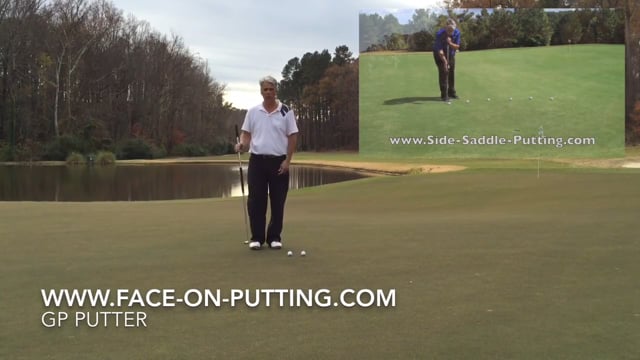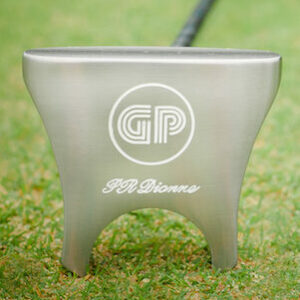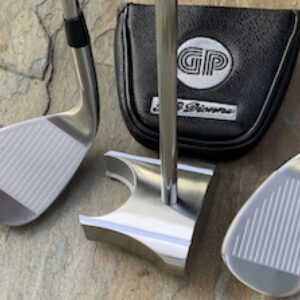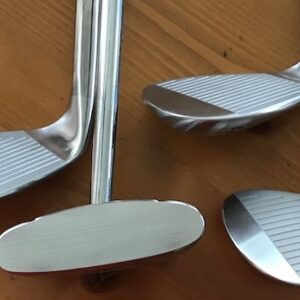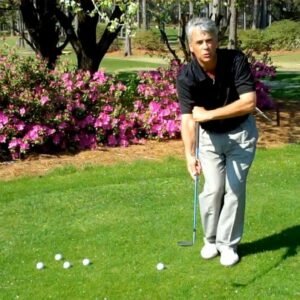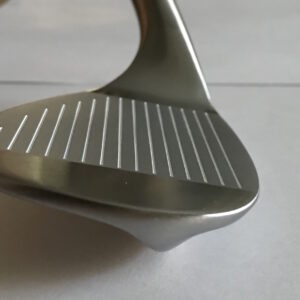Enhance Your Putting Statistics with 'Putt Face-On' Experiment
Grab your putter and take a moment to review your putting technique. When you first learned how to putt, you probably received the tip to crouch and align your eyes with the ball. However, swinging a golf club on the tee or fairway is vastly different from putting on the green. Unlike the power swing with a driver or iron, which involves wrist action for delivering power to the ball, putting requires accuracy over power.
Greens today are mowed even tighter than ever, with the new grass types that can survive the tightest mowing. That makes greens fast and, if there’s even a slight problem with your putting stroke, the speed from tightly mowed greens will only aggravate the situation. You’re looking for a putter that will naturally guide your stroke without effort into the best way of how to putt. That’s why you see so many types of grips for putters and so many different shapes of putter heads. Putt Face-on is the answer.
Golf professionals have done their own putter review covering all the types of putters for sale and have found that it’s not the grip or the head shape that makes the most difference in figuring out how to putt the best way you can but rather the length of the putter. The long shaft and face putting have become the best ways to improve your putting. Putt Face-on will increase your precision and accuracy by leaps and bounds because you’ve left out the wrist action that’s merely a holdover from the power swing you use off the tee and in the fairway.
Just imagine what Sam Snead would have done standing taller and using the Putt Face-on approach with the GP putter!
Embracing the ‘Putt Face-On’ Technique
For anyone who has tried to learn how to play golf, getting familiar with the different shots surely takes some getting used to. Depending on a variety of factors, each scenario might call for a different kind of shot which would guarantee your success in a game. One shot considered as essential by many is called the putt, the objective of which is to roll the ball in order to put it into the hole. For this type of shot, not only is a special type of club used, but there are also some variations in technique to ensure a good shot.
Putt Face-on
Explore our instructional video series, which focuses on the fundamental setup for the ‘Putt Face-On’ technique, an innovative technique also known as side saddle putting. This approach differs from traditional methods due to its distinctive body positioning. Instead of the typical sideways stance, golfers adopting this technique face the target in an upright posture. To delve deeper into mastering this method, our video tutorials illustrate the necessary steps, including bending the legs, positioning the feet closer together, and aligning the ball slightly to the right and in front of the right foot. Discover how to grip the putter with the left hand, placing it just in front of the right chest, while the right hand grips the putter from directly behind the grip. Elevate your putting game by observing our detailed video content on the essential basics of this innovative approach.
No Anchoring
As per the recent updates in golf regulations from the United States Golf Association (USGA), effective since January 2016, the permissible putt face-on technique has undergone changes, disallowing the anchoring of the putter to the body. This alteration is crucial to consider during your practice sessions, ensuring compliance with the updated rules.
Now, let’s delve deeper into the key elements that play a pivotal role in sinking that important putt. It begins with visualizing an imaginary line connecting the ball to the hole, aligning your putter vertically along this line. Shifting your body weight to the right foot, lifting it slightly while using the other foot for stability, sets the foundation for your stance. Once your position is established, initiate a smooth, pendulum-like stroke to strike the ball accurately toward the hole. When executed with precision, this technique offers an advantage in terms of putting accuracy.
Sidesaddle putting serves as a valuable aid, providing a clear view of your target with both eyes while facing it directly. This approach is effective in reducing the likelihood of experiencing the yips. Employing the pencil putting grip minimizes unintended manipulation of the GP putter head during the stroke, enhancing the effectiveness of sidesaddle putting.
It’s important to note that the putting techniques demonstrated in the videos available on this website are entirely legal for use in any golf tournament worldwide. As you practice, a helpful tip involves focusing on a straight six-foot line on the putting green, repeatedly attempting putts until you achieve an 80% success rate. This consistent practice not only aids in overcoming the yips but also sharpens your sidesaddle putting skills, leading to improved performance in your short game.
Invest on a Good Putter
Your collection of golf clubs wouldn’t be complete without a reliable putter in there. The important thing is to find one that would give you an advantage in terms of specs. For effective putting, make sure that you check out the size of the putter head, which has proven to be an essential factor in achieving the perfect pendulum motion needed to achieve that perfect shot. You could check out several reliable brands available in the market like “Scotty Cameron, ping putters, Yes putters” most of which have websites showcasing their different products. The GP putter, for example, conforms to the rules and regulations of the USGA without compromising form and function.
If you are in the area please come to DUKE University and try out all 4 golf clubs.
The golf course is open 7 days a week.
When you analyze the putting statistics from the PGA Tour, a significant gap becomes evident between the top-ranked player and the 192nd position holder. These professionals, deemed the finest in the world, showcase a marked variance in their putting performances. Consider the impact of honing your skills within the 10-foot range using the face-on putting technique – an approach that could dramatically diminish the number of putts you average per round.
The discrepancy in putting performance among the top-tier PGA players signifies the potential for improvement, even at the highest level of the sport. Focusing on refining your short game with the face-on putting technique within the crucial 10-foot range offers a promising opportunity to reduce the number of putts per round. By adopting this method, you stand to enhance your putting proficiency and significantly lower your overall score on the course.

